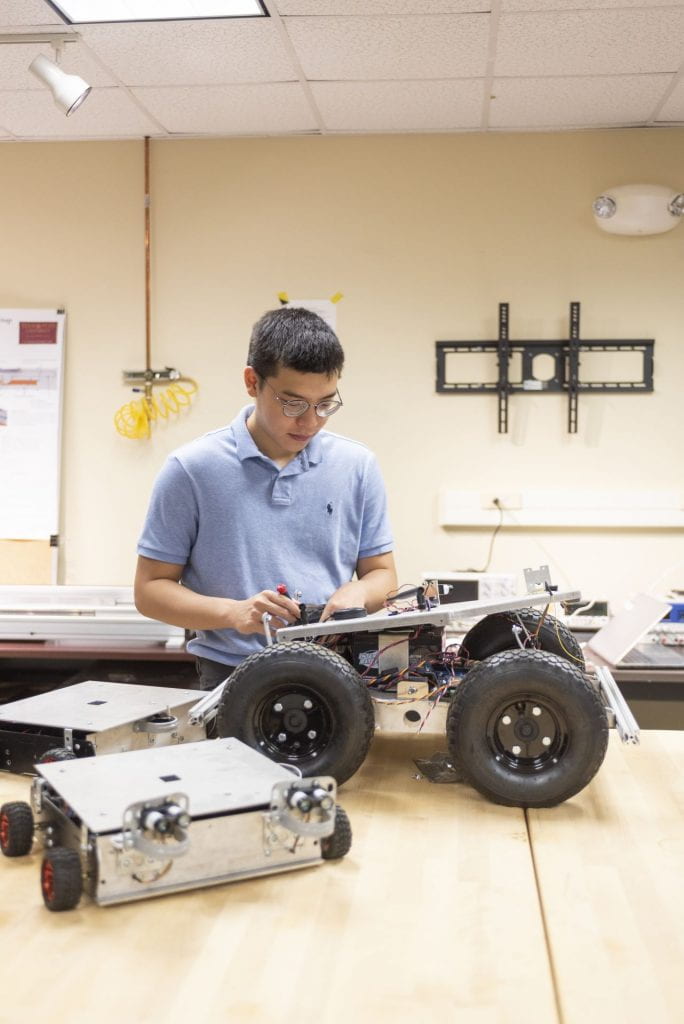
Autonomous mobile robots are one of the electromechanical systems that are widely used in manufacturing facilities. Their applications vary from transportation of parts between different workstations and parts delivery to performing industrial tasks. Although the performance of the mobile robots has been improved significantly in recent years, their mobility is still remained as a big challenge, which highly depends on the terrain that they are running on [1, 2]. Different terrain identification/classification algorithms have been developed in the literature [3-7]. Utilizing a robust train identification algorithm, the robot will adapt to the new surface condition through the onboard traction control system and its mobility will be improved significantly.
Employing new sensor technologies, along with sensor fusion and Artificial Intelligence (AI) algorithms leads to improve the robustness and accuracy of the control algorithms in different electromechanical systems [8]. In this Project, a programable autonomous wheeled robot platform will be used, which is instrumented with additional sensors to capture its dynamics properly, also to detect the terrain type (currently available at the ROBOCO Lab); a six-DOF Inertial Measurement Unit (IMU) on the chassis, and a set of piezoelectric patch and tri-axial accelerometer inside one of the robot’s wheels (attached to the tire inner-liner) to monitor the interaction between the robot’s tire and the road. The Robot will be tested on different terrains (asphalt, concrete, soil, etc.) with different velocities [9]. The collected data will be analyzed in time and frequency domain to extract the features, which are correlated to the terrain type [10, 11]. These features then will be used to develop an AI-based algorithm to identify the surface type based on the vibration of the chassis and the signals from the instrumented tire [12, 13]. Once the terrain was identified, a simple adaptive traction control algorithm (based on the optimum value of slip ratio on each terrain) will be developed.
Dr. Khaleghian leads this project.
[1] C. Wang, W. Lv, X. Li, and M. Mei, “Terrain adaptive estimation of instantaneous centres of rotation for tracked robots,” Complexity, vol. 2018, 2018.
[2] S. Ramasamy, R. Sabatini, A. Gardi, and J. Liu, “LIDAR obstacle warning and avoidance system for unmanned aerial vehicle sense-and-avoid,” Aerospace Science and Technology, vol. 55, pp. 344-358, 2016.
[3] L. Lu, C. Ordonez, E. G. Collins Jr, E. Coyle, and D. Palejiya, “Terrain surface classification with a control mode update rule using a 2D laser stripe-based structured light sensor,” Robotics and Autonomous Systems, vol. 59, pp. 954-965, 2011.
[4] S.-Y. Lee and D.-M. Kwak, “A terrain classification method for UGV autonomous navigation based on SURF,” in 2011 8th International Conference on Ubiquitous Robots and Ambient Intelligence (URAI), 2011, pp. 303-306.
[5] R. Manduchi, A. Castano, A. Talukder, and L. Matthies, “Obstacle detection and terrain classification for autonomous off-road navigation,” Autonomous robots, vol. 18, pp. 81-102, 2005.
[6] B. Park, J. Kim, and J. Lee, “Terrain feature extraction and classification for mobile robots utilizing contact sensors on rough terrain,” Procedia Engineering, vol. 41, pp. 846-853, 2012.
[7] S. Khaleghian, A. Emami, and S. Taheri, “A technical survey on tire-road friction estimation,” Friction, vol. 5, pp. 123-146, 2017.
[8] D. Maurya, P. Kumar, S. Khaleghian, R. Sriramdas, M. G. Kang, R. A. Kishore, et al., “Energy harvesting and strain sensing in smart tire for next generation autonomous vehicles,” Applied energy, vol. 232, pp. 312-322, 2018.
[9] S. Khaleghian and S. Taheri, “Terrain classification using intelligent tire,” Journal of Terramechanics, vol. 71, pp. 15-24, 2017.
[10] P. Behroozinia, S. Khaleghian, S. Taheri, and R. Mirzaeifar, “An investigation towards intelligent tyres using finite element analysis,” International Journal of Pavement Engineering, vol. 21, pp. 311-321, 2020.
[11] P. Behroozinia, S. Khaleghian, S. Taheri, and R. Mirzaeifar, “Damage diagnosis in intelligent tires using time-domain and frequency-domain analysis,” Mechanics Based Design of Structures and Machines, vol. 47, pp. 54-66, 2019.
[12] S. Khaleghian, O. Ghasemalizadeh, and S. Taheri, “Estimation of the tire contact patch length and normal load using intelligent tires and its application in small ground robot to estimate the tire-road friction,” Tire Science and Technology, vol. 44, pp. 248-261, 2016.
[13] S. Khaleghian, O. Ghasemalizadeh, S. Taheri, and G. Flintsch, “A Combination of Intelligent Tire and Vehicle Dynamic Based Algorithm to Estimate the Tire-Road Friction,” SAE International Journal of Passenger Cars-Mechanical Systems, vol. 12, 2019